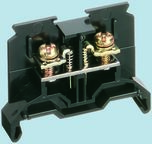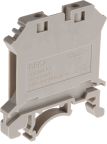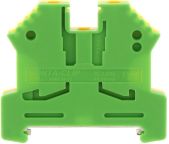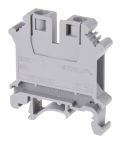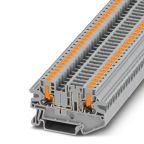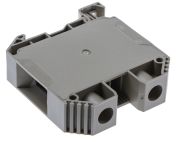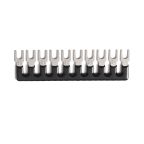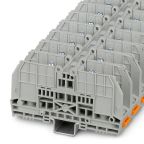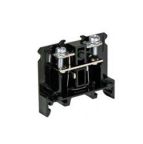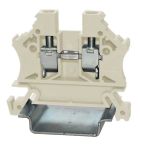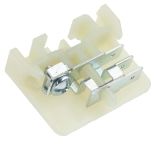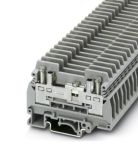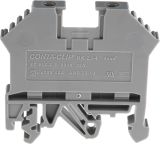A terminal block is a type of insulated electrical connector that connects or secures two or more wires together. They enable the safe connection of wires between circuits. Terminal blocks, also known as terminal strips or connection blocks, are used in a wide range of industrial, commercial, and domestic applications. RS offers an extensive selection of high-quality components from leading suppliers, including Weidmuller, Phoenix Contact, WAGO, ABB, Entrelec, and of course, RS PRO.
What are Terminal Blocks Used For?
Terminal blocks are typically used in industrial power, control, automation, and signal applications where several connections are needed at any one time. Connectors are typically mounted on DIN rail and fixed into panels or electrical enclosures.
Types of Terminal Blocks
Terminal blocks are essential components in electrical systems, providing a secure and organized way to connect multiple wires. They come in various types, each designed for specific applications and environments.
Screw Clamp Terminals
Screw clamp terminals are a common type of industrial terminal block widely recognized for their reliability and ease of use. They feature a design where wires are inserted into the terminal block and secured by tightening a screw, which compresses the wire against a conductive strip. This method ensures a strong connection, making them suitable for various applications, including industrial control panels and power distribution systems.
Spring Clamp Terminals
Spring clamp terminals utilize a spring mechanism to securely hold wires in place without the need for tools. When the wire is inserted into the electrical terminal block, the spring clamps down, providing a strong grip that is particularly effective in environments prone to vibration. This design allows for quick installation and removal, making them ideal for applications requiring frequent maintenance.
Push-In Technology
Push-in technology simplifies the terminal block connector process by allowing users to insert wires directly into the terminal block without any tools. This method is compatible with both solid and stranded conductors (with ferrules) and significantly reduces installation time. Push-in terminals are particularly beneficial in automation systems where efficiency is paramount.
DIN Rail Terminal Blocks
DIN rail terminal blocks are designed for mounting on standard DIN rails, providing a modular and organized way to manage connections in control panels. These connection blocks can come in various configurations, including single feed and multi-level designs, which optimize space within enclosures.
PCB Terminal Blocks
PCB terminal blocks, sometimes referred to as wire to board terminal blocks, are specifically designed for direct mounting onto printed circuit boards. They offer various connection methods, including screw and spring clamp types, allowing for secure connections in compact electronic devices. Their space-saving design makes them ideal for consumer electronics and automotive applications.
Pluggable Terminal Blocks
Pluggable terminal blocks consist of a base mounted on a panel and a removable connector that plugs into it. This design facilitates easy disconnection and reconnection of wires, making maintenance simpler and faster. They are commonly used in modular systems where components may need to be replaced or serviced regularly.
Standard Terminal Blocks
Standard terminal blocks serve as basic terminal block connectors that provide simple wire connections using screws for securing wires. While they may lack advanced features found in other types, they offer an economical solution for straightforward wiring needs in various applications. Their simplicity makes them suitable for general-purpose use across different industries.
Choosing the Right Terminal Block
Selection Factors
When selecting a terminal block, it's crucial to consider the current and voltage requirements of your application. High-voltage terminal blocks are essential for applications involving substantial power, while low-profile terminal blocks can save space in compact designs. Additionally, environmental conditions, such as temperature and moisture, should influence your choice; for example, a lever terminal block may be preferred for easy wiring in challenging environments. Finally, consider application-specific needs, like whether you require a 3-tier terminal block for complex connections or a single terminal block for simple connections.
Connection Needs
Connection types play a vital role in choosing a terminal block. Feed-through terminal blocks are ideal for applications requiring direct wiring, while PCB terminal blocks provide secure connections on printed circuit boards. For those utilizing a modular setup, DIN rail configurations offer flexibility and ease of installation. Understanding these options will help you choose the right terminal block, ensuring reliable connections whether you’re dealing with high-voltage or low-profile applications.
Specialized Terminal Blocks for Advanced Applications
Industrial and High Voltage Uses
In industrial environments, the choice of terminal blocks is critical for ensuring safety and reliability. Industrial terminal blocks are designed to withstand harsh conditions and facilitate secure connections. For applications requiring higher power supplies, high-voltage terminal blocks provide robust insulation and durability, making them essential for preventing electrical failures. Additionally, feed-through terminal blocks can simplify wiring in these demanding settings, allowing for efficient and organized installations.
Innovative Solutions
Innovative terminal block designs, such as lever terminal blocks and insulated terminal blocks, address specific connection needs. Lever terminal blocks offer easy, tool-free wiring, making them ideal for quick installations and maintenance. Insulated terminal blocks, often made from durable plastic, provide enhanced safety at industrial workplaces by preventing accidental contact with conductive parts. These advancements ensure that users have reliable and efficient solutions tailored to modern application requirements.
Installation and Maintenance Tips
Here are some installation and maintenance tips to help you maximize the longevity and performance of various types of terminal blocks in your applications.
- Preparation and Compatibility: Before installing any electrical terminal block, it's essential to assess the compatibility of your components. Ensure that the chosen terminal block matches the specifications of your application, including current and voltage ratings. This is especially important for insulated electrical connectors, which must be suited to handle the specific conditions of your environment to guarantee safety and performance.
- Proper Mounting: Proper mounting is crucial for the longevity and reliability of terminal blocks. Make sure to secure the electrical terminal block firmly to a stable surface using the appropriate mounting hardware. This prevents movement that can lead to connection failures. If you're using a wire terminal strip, ensure that it is mounted in an easily accessible location for maintenance and future modifications.
- Wiring and Connection: When wiring your terminal blocks, follow best practices to ensure secure connections. Strip wires to the correct length and insert them fully into the block, ensuring a firm grip. For insulated electrical connectors, double-check that all connections are snug to prevent any electrical arcing or short circuits. Proper wiring enhances electrical safety and contributes to the efficiency of your electrical system.
- Routine Inspections: Conducting routine inspections is vital for maintaining the integrity of your terminal blocks. Regularly check for signs of wear, corrosion, or loose connections. This proactive approach helps identify potential issues before they escalate, ensuring the continued reliability of your electrical system.
- Maintenance and Cleaning: Regular maintenance and cleaning of your terminal blocks can extend their lifespan. Use a soft brush or cloth to remove dust and debris that may accumulate over time. For electrical terminal blocks in harsher environments, consider using appropriate cleaning agents to ensure that insulated electrical connectors remain free from contaminants that could compromise their performance.
Shop Terminal Blocks at RS
Explore the extensive range of terminal blocks available at RS, designed to meet all your connection needs. Whether you’re looking for standard terminal block connectors or specialized options, we have you covered.
We also offer exceptional customer support and are always ready to assist you in selecting the perfect terminal block for your application. Our knowledgeable team in the Philippines can help answer any questions you may have about our products, including feed-through terminal blocks and their specific uses.
Enjoy fast and reliable delivery options to ensure your projects stay on track. With RS, you can shop with confidence, knowing that your terminal blocks will arrive promptly and in excellent condition. Browse our selection today and find the right solutions for your electrical needs! For more information on our delivery options and fees, please visit our delivery information page.











